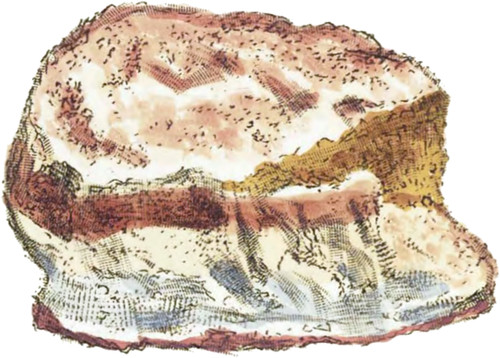 Enlarge
Enlarge
British Mineralogy
- Class 3. Metals.
- Order 2. Oxygenized compounds.
- Gen. 13. Bismuth.
- Spec. 1. Carbonate.
- Div. 1. Amorphous.
This common earthy-looking substance, being chiefly Carbonate of Bismuth, with a little Oxide of Iron, and a very little stony substance, came to me by favour of the Rev. W. Grcgor, from St. Agnes, Cornwall, That gentleman, often usefully employed for his amusement in analysing minerals, is an honour to his country. We think it of much consequence to figure such a substance as the present; for, by remembering the figure or the substance, we shall not too hastily pass over things which at first have common appearances; but examine them with attention, which will habituate the judgement to the easy discrimination of obscure characters, and teach us to suspect what is not quite usual, and therefore to examine it, if necessary, by means of chemical agents.
Nature, in this mineral, seems to point out something of the soapy appearance of Steatite:—see tab. 222; but it is more earthy, or rather harsher to the touch, though the Oxide of Iron in some parts disguises it. The weight in the hand seems greater than that of Steatite, As Oxide of Bismuth has been found a most beautiful and pleasant pigment for high -finishing water- coloured drawings, and as the present specimen does not apparently change colour, as that does, on exposure to light, I was led to think it might afford a lasting pigment, and instead of spoiling many a highly finished drawing, and operating to disgrace the artist, Bismuth might be brought lo recover its own fame in the form of a Carbonate, and be a lasting memorial of the spirit of the artist’s touch; but upon trial I have not found the artificial Carbonate at all equal in lustre to the Oxide.
- Note: From a paper published in Thomson’s Annals, we learn that Mr. Gregor was not the first discoverer of the Carbonate of Bismuth, but that the credit of the discovery properly belongs to Mr. John Mitchell, of St. Austin.

